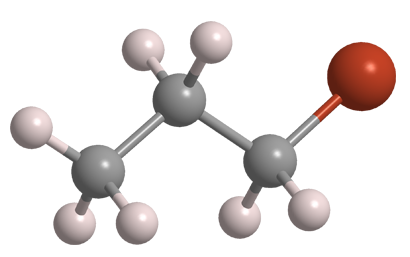What molecule am I?


1-Bromopropane is a simple bromoalkane frequently used as an industrial solvent and degreasing agent. It is prepared commercially via the free-radical anti-Markovnikov hydrobromination of propylene.
Since 2000, 1-bromopropane has increasingly replaced toxic, ozone-depleting chlorocarbons and chlorofluorocarbons as dry-cleaning solvents. But using this brominated hydrocarbon presents many hazards (see hazard information table).
The US Environmental Protection Agency recently began to evaluate the health hazards of 1-bromopropane to workers. In its draft assessment, the agency reported that the solvent could pose “unreasonable risks to workers, occupational nonusers, consumers, and bystanders under certain conditions of use.” EPA is accepting comments on the draft until October 11.
1-Bromopropane hazard information
| GHS classification*: flammable liquids, category 2 | |
| H225—Highly flammable liquid and vapor | |
| GHS classification: skin corrosion/irritation, category 2 | |
| H315—Causes skin irritation | |
| GHS classification: serious eye damage/eye irritation, category 2B | |
| H319—Causes eye irritation | |
| GHS classification: specific target organ toxicity, single exposure; respiratory tract irritation, category 3 | |
| H335—May cause respiratory irritation | |
| GHS classification: specific target organ toxicity, single exposure; narcotic effects, category 3 | |
| H336—May cause drowsiness or dizziness | |
| GHS classification: carcinogenicity, category 2 | |
| H351—Suspected of causing cancer | |
| GHS classification: reproductive toxicity, category 1B | |
| H360—May damage fertility or the unborn child | |
| GHS classification: specific target organ toxicity, repeated exposure; lungs, liver, central nervous system, category 2 | |
| H373—Causes damage to organs through prolonged or repeated exposure | |
| GHS classification: hazardous to the aquatic environment, long-term hazard, category 3 | |
| H412—Harmful to aquatic life with long-lasting effects | |
*Globally Harmonized System of Classification and Labeling of Chemicals. Explanation of pictograms.
MOTW update: September 30, 2019
Isosorbide was the Molecule of the Week for November 22, 2010. It is a sugar dehydration product that has been examined as a safe replacement for bisphenol A in plastics manufacture. At the recent ACS National Meeting in San Diego, Florence Popowycz of the University of Lyon (France) gave a paper based on her 2018 article “Diastereoselective iridium-catalyzed amination of biosourced isohexides through borrowing hydrogen methodology” Popowycz’s process uses corn-derived isosorbide as one of the substrates.
1-Bromopropane fast facts
| CAS Reg. No. | 106-94-5 |
| Empirical formula | C3H7Br |
| Molar mass | 122.99 g/mol |
| Appearance | Colorless liquid |
| Boiling point | 71 ºC |
| Water solubility | 2.5 g/L |
MOTW update:
July 06, 2020
1-Bromopropane is the Molecule of the Week for September 30, 2019. The hazards associated with this valuable industrial solvent and degreasing agent were reviewed in 2019 by the US Environmental Protection Agency. The agency reported that it could pose “unreasonable risks to workers, occupational nonusers, consumers, and bystanders under certain conditions of use.” In June 2020, EPA added 1-bromopropane to its list of hazardous air pollutants under the Clean Air Act—the first chemical added since the act was amended in 1990.
MOTW update:
November 18, 2019
Former Molecules of the Week 1,4-dioxane, hexabromocyclododecane, 1-bromopropane, N-methyl-2-pyrrolidone, and dichloromethane, among several other chemicals, are at the center of a controversy about how the EPA’s scientific advisory committees are evaluating risks of air pollution. The problems are the lack of expertise in some of the committees and a shortage of adquate data to evaluate the chemicals. Industrial and environmental stakeholders are critical of the latest risk assessments.

Learn more about this molecule from CAS, the most authoritative and comprehensive source for chemical information.
Molecule of the Week needs your suggestions!
If your favorite molecule is not in our archive, please send us a message. The molecule can be notable for its current or historical importance or for any quirky reason. Thank you!
Stay Ahead of the Chemistry Curve
Learn how ACS can help you stay ahead in the world of chemistry.

